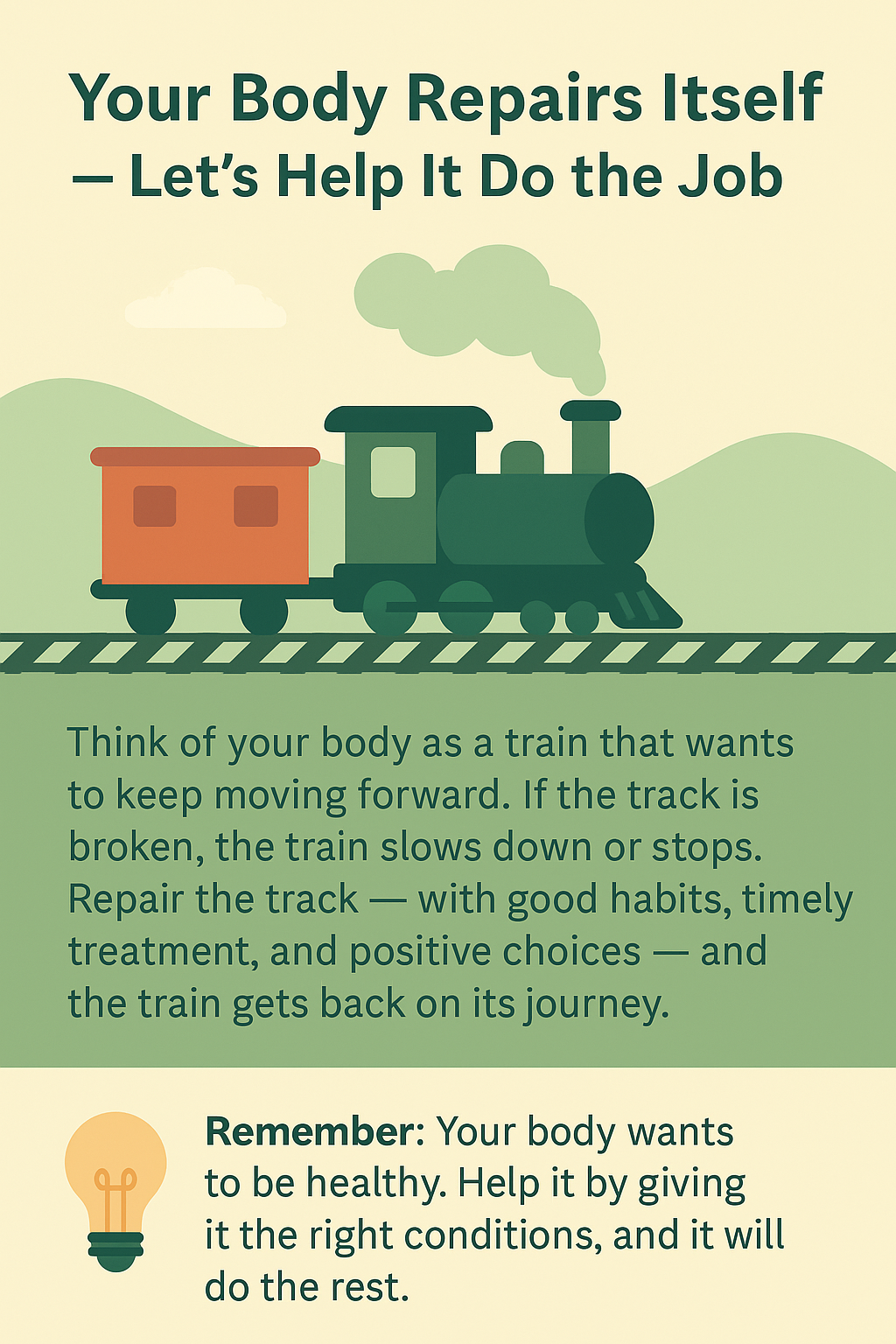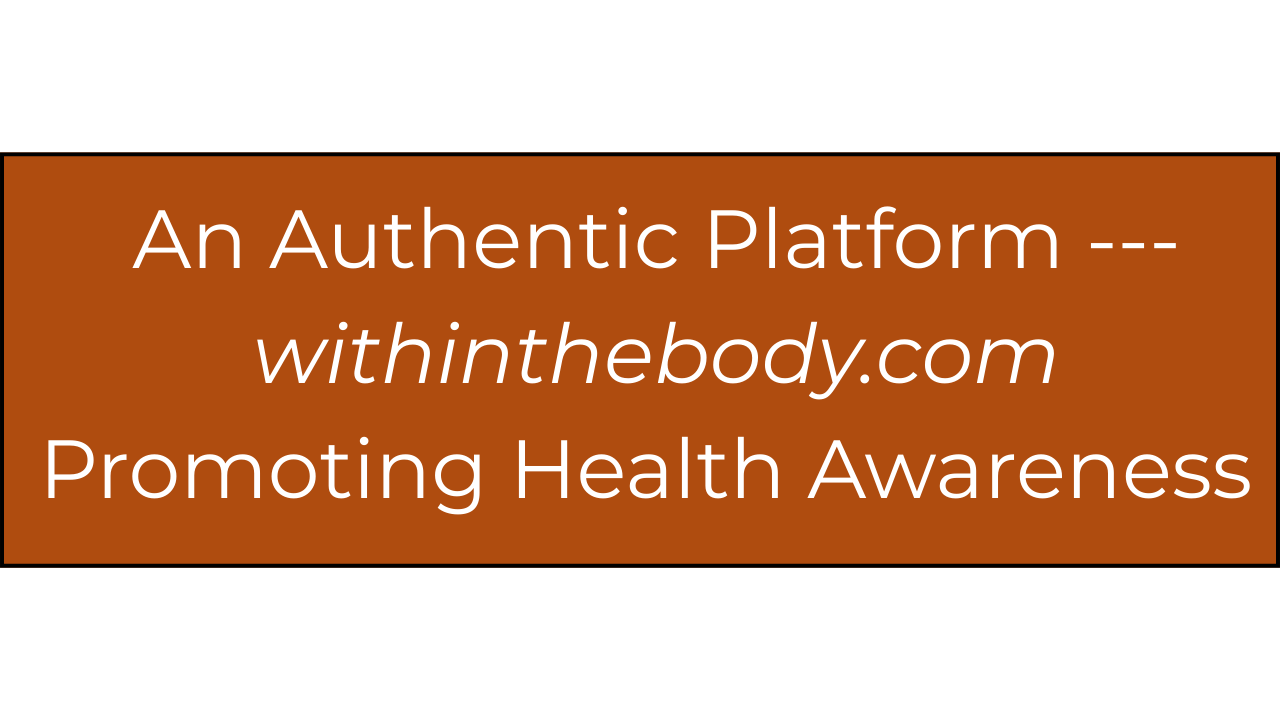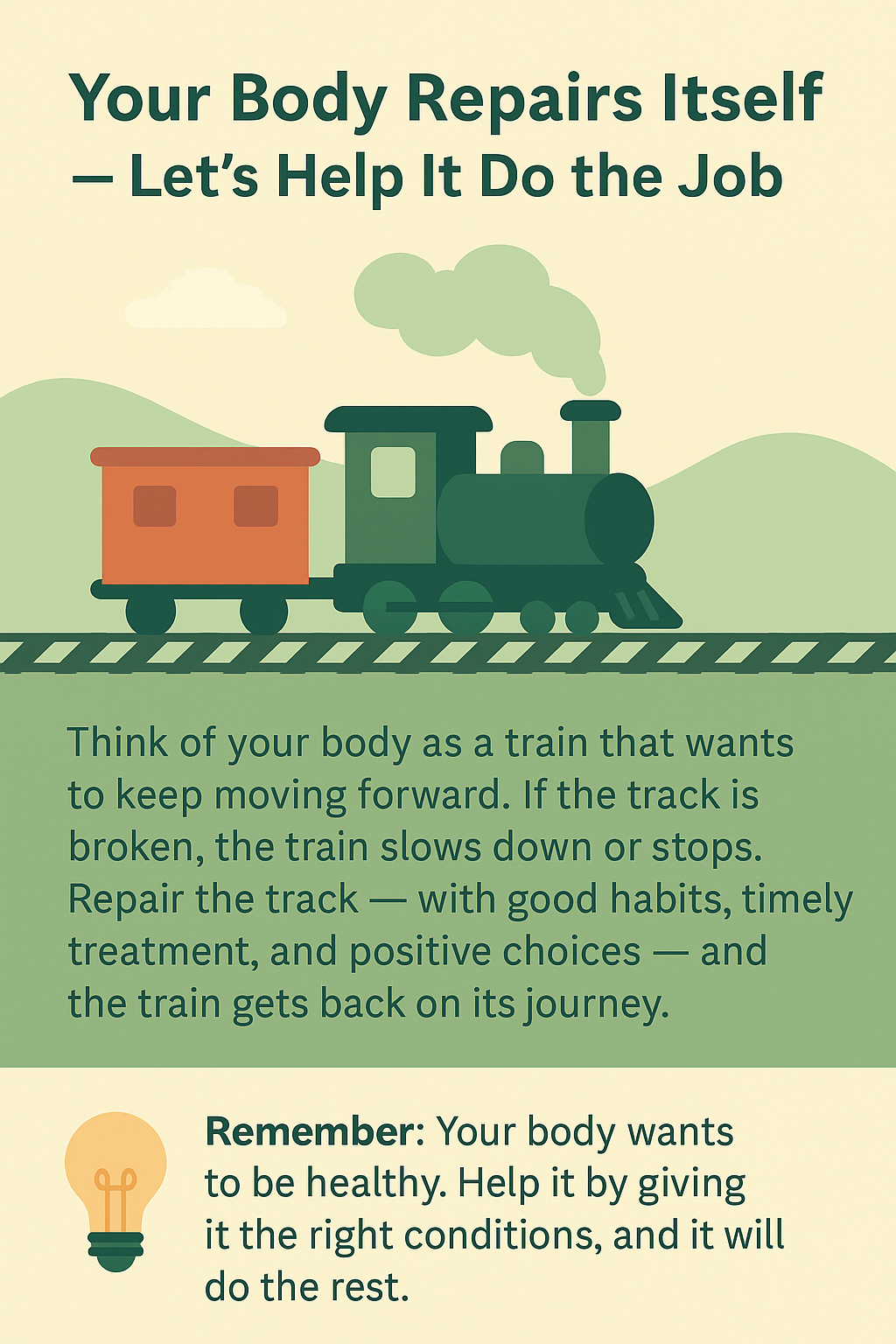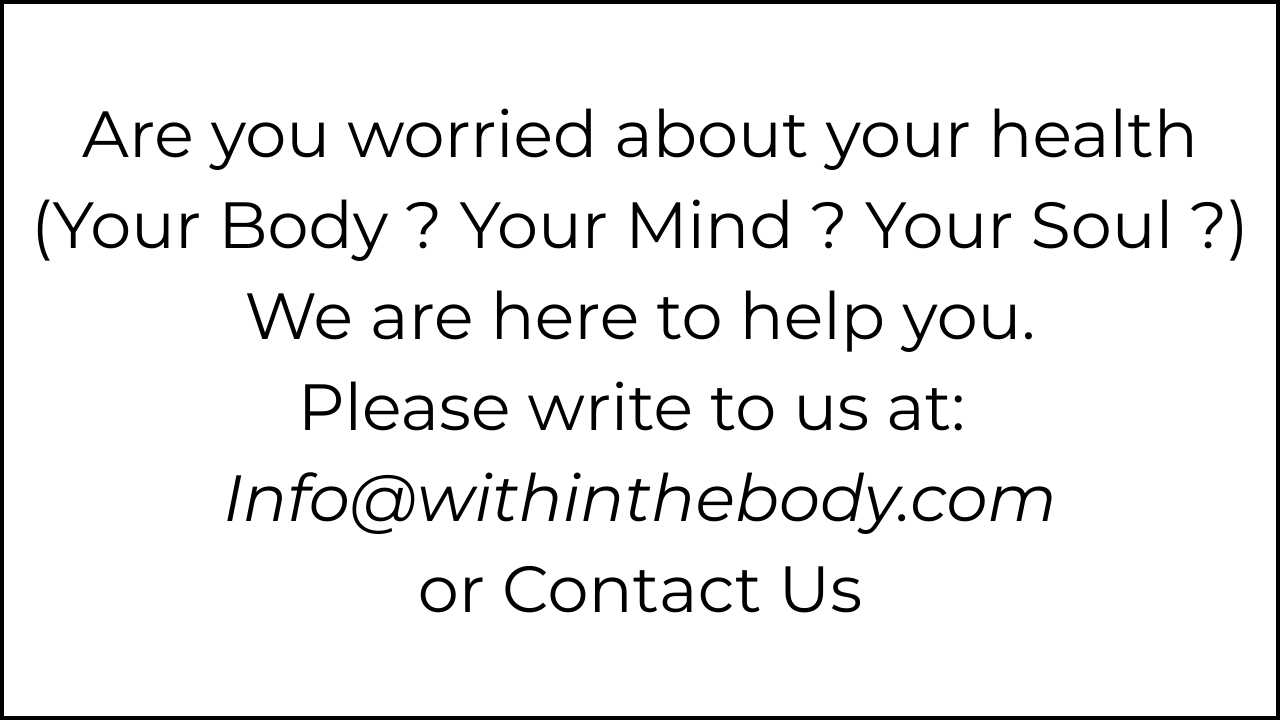Body Repairs Itself — Just Bring It Back on Track, From Disorder to In Order


As physicians, one of the most remarkable observations we make daily is the body’s inherent tendency to heal itself. No matter how complex the disruption — be it an infection, inflammation, injury, or even emotional stress — the human body carries within it the machinery for repair and restoration. What it needs most from us is not constant interference, but rather careful guidance: the right environment, the right choices, and timely medical support to redirect it from disorder back to order.
The Natural Repair System
Every cell in the body has a purpose and a cycle. Damaged tissues trigger cascades of chemical messengers, immune responses, and repair mechanisms aimed at healing. A cut on the skin closes without our command. A broken bone reattaches itself, rebuilding with astonishing precision. Even the heart and brain, once thought incapable of repair, show evidence of regenerative potential when given the right support.
Disorder occurs when the body is pulled off its natural track — through poor diet, lack of rest, sedentary lifestyle, addictions, chronic stress, or uncontrolled illnesses. Yet even here, the moment the load is lifted, the body begins moving toward balance. Blood pressure normalizes when salt and stress are reduced. Blood sugar improves with disciplined food choices and activity. Mental clarity returns when sleep is restored. The principle is simple: the body wants to be well.
Physician’s Role: Guiding, Not Forcing
The physician’s task is not to “create” healing but to remove barriers to it. Antibiotics, for instance, do not heal; they only weaken bacteria so the immune system can complete the job. Antihypertensive drugs reduce pressure on the vessels so the heart is protected while the patient realigns lifestyle. Counseling relieves the mind, but the actual healing of trauma is a process initiated by the individual’s brain and spirit.
From Disorder to Order
Think of the human body as a train derailed. The healing force is the engine — always present, always ready. But if the track is broken, the engine cannot move forward. Our role as doctors, and yours as a caretaker of your own health, is to repair and align the track. This means:
• Nutrition: Supplying the raw material for repair — proteins, vitamins, minerals.
• Rest: Allowing energy to shift from activity to repair.
• Movement: Enhancing circulation, oxygenation, and hormonal balance.
• Clean Environment: Protecting against toxins, infections, and stressors.
• Medical Interventions: Correcting what cannot be corrected naturally, but never replacing the natural process itself.
The Take-Home Message
Your body is not a passive machine waiting to break down. It is an active, living, self-repairing system. Disorders — whether metabolic, structural, or psychological — are often not permanent failures, but detours. The path back to health lies in bringing the system back on track.
As physicians, we stand not as controllers of life but as facilitators of nature’s most powerful truth: the body heals itself, if

1. For Medical Students
Body Repairs Itself — Just Bring It Back on Track
As you begin your medical journey, it is essential to understand a fundamental truth: the body has an innate capacity for healing. Every system — cardiovascular, immune, musculoskeletal, or nervous — is equipped with repair mechanisms that function constantly, often without our conscious awareness.
When a wound occurs, platelets aggregate, clotting cascades activate, and tissue repair follows. When infection sets in, the immune system mounts a defense, assisted by fever, antibodies, and phagocytosis. Even in chronic illnesses like hypertension or diabetes, the body continually attempts to restore balance, though these efforts may be overwhelmed without intervention.
Your role, as future physicians, is to recognize this self-repairing nature. Treatments are not cures in themselves but supportive measures: antibiotics facilitate immunity, antihypertensives reduce workload on the heart, and surgery often provides structure for the body to complete healing. The art of medicine lies in knowing when to intervene and when to allow the body’s own processes to work.
Always remember: healing is not imposed; it is facilitated. Learn to identify the barriers to natural recovery — poor nutrition, lack of rest, stress, or harmful habits — and work to remove them. This will shape you into a physician who respects both science and the wisdom of the human body.
2. For Young Doctors
From Disorder to Order: The Body’s Self-Repair
As you transition from textbooks to practice, one lesson stands out: the body heals itself when brought back onto the right track. Disorders — whether metabolic, infectious, or psychological — represent derailments of normal physiology. Yet, once the triggers are addressed, restoration follows.
In the clinic, you will see wounds closing with minimal intervention, fractures knitting over time, and blood pressure normalizing with lifestyle adjustments. Your task is not to “command” healing but to facilitate it. Prescribing an antibiotic does not kill all bacteria — it simply tips the balance in favor of the immune system. Giving a statin does not erase plaques instantly — it slows progression while the endothelium repairs itself.
As a young physician, avoid the temptation of over-medicalization. Do not underestimate the effect of rest, nutrition, physical activity, and mental peace. Drugs and procedures have their place, but they work best when the patient’s own repair system is allowed to function optimally.
Think of yourself as a guide: you realign the tracks, but the body’s engine does the healing. Never forget that your patient is not just a diagnosis but a living, self-repairing system.
3. For General Practitioners
Body Repairs Itself: Guiding Patients Back to Balance
In family practice, you see every form of disorder — infections, injuries, chronic diseases, psychological stress. Yet across all these conditions, one principle holds true: the human body strives to repair itself, and our job is to help it succeed.
Patients often look for quick fixes. They expect antibiotics to cure, analgesics to erase pain, or procedures to resolve everything. It is our responsibility to explain that medicines and interventions are aids, not replacements, for the natural healing system. For example, hypertension control depends not only on drugs but also on weight management, reduced salt intake, and stress control. Similarly, diabetes care requires discipline in food and lifestyle, alongside pharmacological support.
As GPs, we are positioned to emphasize prevention and holistic care. By guiding patients back toward balanced nutrition, adequate sleep, physical activity, and a healthy mental environment, we repair the “track” on which their body’s healing engine runs.
The message to every patient should be clear: your body wants to heal; my role as your physician is to remove the obstacles. This philosophy not only improves outcomes but also strengthens the trust and partnership between doctor and patient.
Now you have three versions: educational for students, transitional for young doctors, and practical for general practitioners.
For our readers:
Your Body Repairs Itself — Let’s Help It Do the Job
One of the greatest miracles of life is that your body is always trying to heal itself. A small cut closes on its own. A broken bone slowly joins back together. Even after illness, your strength and energy often return without you realizing the work your body has done.
But sometimes the body goes “off track.” Poor diet, lack of sleep, stress, smoking, and long-term illnesses like diabetes or high blood pressure can disturb this natural repair system. The good news? The moment you start making the right choices, your body begins moving back toward health.
As doctors, we don’t “create” healing. Medicines, surgeries, or treatments are there only to support the body’s own repair work. Antibiotics help the immune system fight infection. Blood pressure medicine protects the heart while you improve your lifestyle. Rest, healthy food, regular movement, and peace of mind are often as powerful as any prescription.
Think of your body as a train that wants to keep moving forward. If the track is broken, the train slows down or stops. Repair the track — with good habits, timely treatment, and positive choices — and the train gets back on its journey.
Remember: Your body wants to be healthy. Help it by giving it the right conditions, and it will do the rest.
When to See the Doctor
While the body has amazing healing power, there are times when medical help becomes essential. You should not delay seeking professional care if you notice:
• Persistent Symptoms: Fever, cough, pain, fatigue, or digestive problems that last more than a few days without improvement.
• Sudden or Severe Changes: Chest pain, shortness of breath, sudden weakness, confusion, or vision changes.
• Non-Healing Wounds: Cuts, ulcers, or injuries that do not heal in a normal time frame.
• Unexplained Weight Changes: Significant weight loss or gain without reason.
• Recurring Illness: Frequent infections or repeated flare-ups of the same problem.
• Mental Health Concerns: Persistent sadness, anxiety, sleep problems, or loss of interest in daily life.
• Chronic Disease Monitoring: If you have conditions like diabetes, hypertension, or heart disease, regular check-ups are vital to keep your body “on track.”
Remember: Early medical attention often means easier treatment and better outcomes. Trust your body’s signals — they are not to be ignored.
